|
|
|
Sort Order |
|
|
|
Items / Page
|
|
|
|
|
|
|
| Srl | Item |
| 1 |
ID:
105679


|
|
|
|
|
| Publication |
2011.
|
| Summary/Abstract |
Authoritarianism in the Arab world has had a propensity to endure for decades and was seen as an essential political feature in a region where democratisation was said to flounder. Yet, authoritarian regimes are exhausted and weakened. It took massive social mobilisation in 2011 in Tunisia and Egypt to topple them. Those societies have gained an essential voice in the political process with an aspiration for democracy. Transition was about to open up to chaos and then a specific actor, the military, stepped in to smooth the transition. The next step in Tunisia and Egypt is the delicate rebuilding of governments to fulfill this aspiration for democracy as well as to provide a demonstration effect for the new model of transition throughout the Arab world.
|
|
|
|
|
|
|
|
|
|
|
|
|
|
|
|
| 2 |
ID:
105691
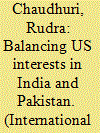

|
|
|
|
|
| Publication |
2011.
|
| Summary/Abstract |
Convincing the Pakistani military to focus its attention on the Afghan Taliban and associated groups has so far proved unsuccessful. The Obama administration's reliance on economic incentives and regional peace initiatives, such as a dialogue with India on Kashmir, has failed to deliver tangible results. Instead, India's footprint within Afghanistan has expanded, leaving Pakistani elites ever more anxious. Balancing Indian and Pakistani interests in South Asia remains a top priority for Western governments, and most importantly the US. In the current milieu this will require shifting Western bureaucratic focus from the age old and seemingly intractable Kashmir dispute to maintaining the peace within Afghanistan. This article outlines why this shift should be considered, and how the India--Pakistan trust deficit might be bridged.
|
|
|
|
|
|
|
|
|
|
|
|
|
|
|
|
| 3 |
ID:
105687
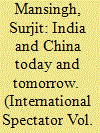

|
|
|
|
|
| Publication |
2011.
|
| Summary/Abstract |
A complex India--China relationship today reflects efforts by both governments for over twenty years to improve relations frozen since 1962. The boundary question has not yet been resolved, however, and China's recent assertiveness along its periphery combined with accelerating military capabilities causes anxiety in India. China worries about India's new partnerships with the United States and Japan. Meanwhile, the economies of both grow rapidly with increasing exchanges of goods and services. The two governments have learned to manage differences. The future relationship between these two Asian giants will be bright if they can cooperate in their shared neighbourhoods, but dark if mistrust and rivalry dominate perceptions.
|
|
|
|
|
|
|
|
|
|
|
|
|
|
|
|
| 4 |
ID:
105690


|
|
|
|
|
| Publication |
2011.
|
| Summary/Abstract |
The evolution of India--US relations in the last two decades has been remarkable, and the two countries are closer now than they have ever been. On the one hand, the rapid expansion of India's Western-influenced middle class has pushed the country to align with many American positions; on the other hand, the US too has recognised India's growing importance in a post-9/11 world. The principal driver of this relationship is a growing convergence of economic and strategic interests, with the existence of a large and successful Indian diaspora in the US acting as a further valuable bridge. American military aid to Pakistan remains an unsettling factor in this relationship, but both sides are learning to manage their differences without abandoning their core concerns or creating a crisis. Short of an unexpected shock to the system, India--US relations will continue to improve steadily in the future and become one of the most exciting partnerships in the 21st century.
|
|
|
|
|
|
|
|
|
|
|
|
|
|
|
|
| 5 |
ID:
105686
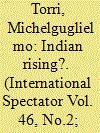

|
|
|
|
|
| Publication |
2011.
|
| Summary/Abstract |
There is no doubt that the Indian economy is one of the fastest growing in the world. However, such growth has been socially unbalanced, benefitting only a minority of the population. This, in turn, has brought about huge and increasingly dangerous social and political problems, such as an epidemic of suicides among farmers and the resurgence of the Maoist 'people's war'. Nevertheless, while Indian growth is limited to a minority of the population, it is real and important. Only the future can tell if, true to some projections, India will become the third or first world economy by 2050. What is certain however is that, because of the rapid economic development of the past three decades, India has already become a key world player.
|
|
|
|
|
|
|
|
|
|
|
|
|
|
|
|
| 6 |
ID:
105699
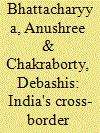

|
|
|
|
|
| Publication |
2011.
|
| Summary/Abstract |
In the last decade, infrastructure development initiatives across borders, both in South and Southeast Asia, have emerged as a major tool of economic diplomacy, practiced both by China and India. Indeed, it was China's successful experience of linking with the neighbourhood that motivated India to try to extend influence as well as trade beyond its borders. India's success at developing cross-border connectivity is still quite modest compared to China's achievements, but in the long term, India's connectivity drive in its immediate and extended neighbourhood should contribute significantly to supporting its economic growth and providing a counterbalance to Chinese influence in the region.
|
|
|
|
|
|
|
|
|
|
|
|
|
|
|
|
| 7 |
ID:
105696
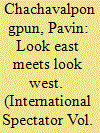

|
|
|
|
|
| Publication |
2011.
|
| Summary/Abstract |
India has been eager to expand its economic networks with Southeast Asia, one of the most vibrant segments of the world economy, accounting for a large share of global exports. In addition to the economic links required to feed India's fast growing economy, greater cooperation and integration is considered a way of promoting development in India's northeast as well as the less-developed Southeast Asian countries. While some fear growing rivalry in the area between India and China, their growing commercial interests are more likely to lead to enhanced cooperation, given the need to build up a peaceful environment to protect their business interests in the region. The competition could also prove beneficial to Southeast Asia itself, spurring economic openness and competition.
|
|
|
|
|
|
|
|
|
|
|
|
|
|
|
|
| 8 |
ID:
105684


|
|
|
|
|
| Publication |
2011.
|
| Summary/Abstract |
On 9 July 2011, South Sudan will become formally independent. Will it be able to avoid becoming a new failed state? And will its leadership be able to meet the high expectations of the Southern Sudanese people? Creating a proper administration and facing the many political and military divisions within the region are just two of the many and multi-faced challenges ahead. The South's secession will affect internal balances in North Sudan as well, while the many issues relating to the future relationship between the two regions will need to be settled to avoid further instabilities.
|
|
|
|
|
|
|
|
|
|
|
|
|
|
|
|
| 9 |
ID:
105702


|
|
|
|
|
| Publication |
2011.
|
| Summary/Abstract |
India's approach to climate change has shifted dramatically in the span of a few years. Not only has India developed a comprehensive climate change program domestically, it has adopted a new stance in the international negotiations that has earned it the reputation of being a 'deal maker'. This dramatic, and to many unexpected, shift in India's climate change strategy can be understood if seen in the context of India's economic and development aspirations and the changes occurring in the larger geopolitical landscape. Climate change, due to its multi-faceted nature, cuts across a spectrum of issues and India can benefit both domestically and internationally by addressing it.
|
|
|
|
|
|
|
|
|
|
|
|
|
|
|
|
|
|
|
|
|